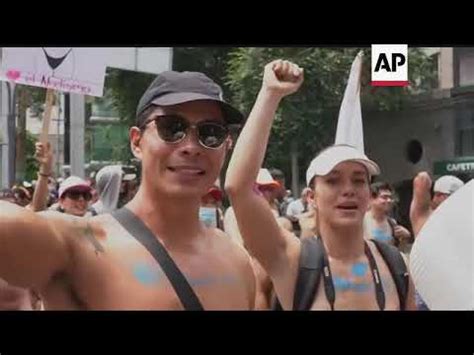
Hundreds of nudists marched through the heart of Mexico City on Saturday, advocating for body positivity and acceptance in a society often preoccupied with physical appearance. The march, organized by various nudist groups, aimed to promote freedom from societal norms and celebrate the human body in its natural form.
Mexico City Bares All: Nudists March for Body Positivity and Acceptance
Mexico City – Hundreds of individuals shed their inhibitions and clothes on Saturday, participating in a nude march through the bustling streets of Mexico City to champion body positivity and acceptance. The demonstration, orchestrated by nudist collectives, sought to challenge conventional beauty standards and foster a more inclusive and liberated society.
The march commenced at the iconic Monumento a la Revolución, a historical landmark in the city center, and proceeded along Paseo de la Reforma, one of Mexico City’s most prominent avenues. Participants, ranging in age and body type, carried banners and signs emblazoned with messages promoting body acceptance, self-love, and the rejection of societal pressures to conform to unrealistic ideals.
“We are here to celebrate our bodies and to show that nudity is not something to be ashamed of,” stated one participant, Elena Rodriguez, a spokesperson for the organizing group, “Cuerpo Libre” (Free Body). “We want to create a space where people can feel comfortable in their own skin, regardless of their size, shape, or appearance.”
The marchers encountered a mixed response from onlookers. Some expressed support and admiration for the participants’ courage, while others reacted with surprise or discomfort. However, the overall atmosphere remained peaceful and respectful, with organizers emphasizing the importance of dialogue and education in challenging societal norms.
“It’s not about exhibitionism; it’s about liberation,” explained Marco Hernandez, another organizer. “We want to break down the stigma surrounding nudity and show that the human body is beautiful in all its forms. This is about promoting self-acceptance and challenging the unrealistic standards that are constantly imposed on us by the media and society.”
The march in Mexico City is part of a growing global movement advocating for body positivity and challenging restrictive social norms related to appearance. Similar events have taken place in cities around the world, reflecting a growing awareness of the negative impact of body shaming and the importance of promoting self-acceptance and inclusivity.
The organizers of the Mexico City march hope that their efforts will contribute to a broader cultural shift towards greater acceptance and appreciation of body diversity. They plan to continue organizing events and initiatives to promote body positivity and challenge societal norms that perpetuate unrealistic and harmful ideals.
The march was conducted under the watchful eye of local authorities, who ensured the safety and security of participants and bystanders. While nudity is not explicitly illegal in Mexico City, organizers obtained the necessary permits and coordinated with law enforcement to ensure a peaceful and orderly event.
The event garnered significant attention on social media, with both supporters and critics weighing in on the march’s message and impact. Many praised the participants for their bravery and commitment to promoting body positivity, while others questioned the appropriateness of public nudity.
Despite the mixed reactions, the organizers remain committed to their cause, believing that their efforts are essential in creating a more inclusive and accepting society for all. They plan to continue organizing events and initiatives to promote body positivity and challenge societal norms that perpetuate unrealistic and harmful ideals. The success of the march in Mexico City serves as a testament to the growing momentum of the body positivity movement and its potential to transform societal attitudes towards appearance and self-acceptance.
The marchers highlighted that the event was not intended to be sexually provocative or disrespectful but rather a peaceful demonstration of their right to express themselves and celebrate their bodies. They emphasized that nudity is a natural state and should not be associated with shame or stigma.
The organizers also stressed the importance of consent and respect, urging participants and onlookers to refrain from taking photographs or videos without permission. They emphasized that the march was about creating a safe and inclusive space for everyone, regardless of their comfort level with nudity.
The event also attracted the attention of local artists and activists, who saw it as an opportunity to promote their own messages of body positivity and social justice. Many artists created artwork inspired by the march, while activists used the event to raise awareness about issues such as eating disorders, body shaming, and the objectification of women.
The march in Mexico City is a significant step forward for the body positivity movement in Mexico, a country where traditional beauty standards often prevail. It represents a growing awareness of the need to challenge these standards and create a more inclusive and accepting society for all.
The impact of the march is likely to extend beyond the immediate event, as it has sparked a conversation about body positivity and acceptance that will continue to resonate in the media and in everyday life. The organizers hope that their efforts will inspire others to embrace their bodies and challenge the norms that perpetuate unrealistic and harmful ideals.
This event underscores a critical dialogue about societal expectations and the freedom of expression. The marchers are not merely exhibiting themselves; they are making a statement about the right to exist without judgment and to challenge the pervasive culture of body shaming. By taking to the streets, they are reclaiming public space and asserting their right to be seen and accepted for who they are, regardless of physical appearance.
The broader implications of this event extend to the realms of mental health and well-being. The constant pressure to conform to unrealistic beauty standards can lead to anxiety, depression, and eating disorders. By promoting body positivity, the marchers are contributing to a more supportive and inclusive environment where individuals feel empowered to embrace their unique qualities and reject harmful societal expectations.
Furthermore, the march highlights the importance of education and awareness in challenging deeply ingrained societal norms. Many people have never been exposed to the concept of body positivity or have misconceptions about nudity and its association with sexuality. By engaging in public dialogue, the marchers are helping to dispel these misconceptions and promote a more nuanced understanding of the human body and its diverse forms.
The organizers are acutely aware of the potential for misinterpretation and have taken steps to ensure that the event is conducted in a safe and respectful manner. They have worked closely with law enforcement to address any security concerns and have provided clear guidelines for participants and onlookers. They have also emphasized the importance of consent and respect, urging everyone to refrain from taking photographs or videos without permission.
The success of the march in Mexico City is a testament to the power of collective action and the growing momentum of the body positivity movement. It demonstrates that individuals are increasingly willing to challenge societal norms and demand a more inclusive and accepting world. The march is not just about nudity; it is about freedom, empowerment, and the right to exist without judgment.
The long-term impact of the march remains to be seen, but it is clear that it has sparked a conversation that will continue to resonate in Mexico and beyond. The organizers hope that their efforts will inspire others to embrace their bodies, challenge societal expectations, and create a more inclusive and accepting world for all.
The event also highlights the complex relationship between individual expression and public space. While some may view public nudity as inappropriate or offensive, others see it as a legitimate form of protest and a way to challenge societal norms. The march in Mexico City provides an opportunity to explore these competing perspectives and to consider the role of public space in fostering dialogue and promoting social change.
The organizers have emphasized that their goal is not to shock or offend but to create a space for dialogue and understanding. They believe that by challenging societal norms and promoting body positivity, they can contribute to a more inclusive and accepting world for all.
The march in Mexico City is a powerful reminder that body positivity is not just about accepting oneself but also about challenging the societal norms that perpetuate unrealistic and harmful ideals. It is about creating a world where everyone feels comfortable in their own skin and where diversity is celebrated rather than stigmatized.
The march also serves as a platform for marginalized communities to amplify their voices and experiences. Individuals who have been historically excluded from mainstream beauty standards are using the event to share their stories and challenge the norms that have silenced them. By creating a space for diverse voices, the march is fostering a more inclusive and equitable society.
The organizers are committed to continuing their work beyond the march, organizing workshops, educational programs, and other initiatives to promote body positivity and challenge societal norms. They believe that sustained efforts are necessary to create lasting change and to ensure that everyone has the opportunity to live a life free from body shaming and discrimination.
The event underscores the importance of critical thinking and media literacy in navigating the complex world of body image. The media often perpetuates unrealistic beauty standards, and it is essential to develop the skills to critically evaluate these messages and to resist their harmful influence. By promoting media literacy, the organizers are empowering individuals to make informed choices about their own bodies and to resist the pressure to conform to unrealistic ideals.
The march in Mexico City is a testament to the power of community and collective action. By coming together to challenge societal norms and promote body positivity, the participants are creating a sense of belonging and solidarity. This sense of community is essential for fostering resilience and for empowering individuals to overcome the challenges of living in a society that often perpetuates unrealistic and harmful ideals.
The organizers hope that the march will inspire others to take action in their own communities to promote body positivity and challenge societal norms. They believe that everyone has a role to play in creating a more inclusive and accepting world and that even small acts of resistance can make a difference.
The event also highlights the importance of self-care and mental well-being. Living in a society that often perpetuates unrealistic beauty standards can take a toll on one’s mental health. It is essential to prioritize self-care and to seek support from friends, family, or professionals when needed. By promoting self-care and mental well-being, the organizers are helping individuals to develop the resilience to navigate the challenges of living in a society that often prioritizes appearance over substance.
The march in Mexico City is a reminder that body positivity is not just about accepting one’s physical appearance but also about embracing one’s inner self. It is about recognizing one’s worth and value as a human being, regardless of physical attributes. By promoting self-acceptance and self-love, the organizers are empowering individuals to live more fulfilling and authentic lives.
The event also highlights the importance of celebrating diversity and challenging the notion that there is only one way to be beautiful. The organizers believe that beauty comes in all shapes, sizes, colors, and forms and that everyone has something unique and valuable to offer the world. By celebrating diversity, the march is creating a more inclusive and accepting society for all.
The organizers are committed to continuing their work beyond the march, collaborating with other organizations and individuals to promote body positivity and challenge societal norms. They believe that by working together, they can create a more inclusive and equitable world for all.
The march in Mexico City is a powerful example of how individuals can come together to challenge societal norms and promote positive social change. It is a reminder that everyone has a voice and that even small acts of resistance can make a difference. By embracing body positivity and challenging unrealistic beauty standards, we can create a more inclusive and accepting world for all.
FAQ: Nudist March in Mexico City
-
What was the purpose of the nudist march in Mexico City?
The primary goal of the march was to promote body positivity, self-acceptance, and challenge societal norms regarding physical appearance. Participants aimed to demonstrate that nudity is not inherently shameful and to foster a more inclusive environment where people feel comfortable in their own skin, regardless of their size, shape, or appearance. As stated by one of the organizers, “We want to break down the stigma surrounding nudity and show that the human body is beautiful in all its forms. This is about promoting self-acceptance and challenging the unrealistic standards that are constantly imposed on us by the media and society.”
-
Where did the march take place, and who organized it?
The march commenced at the Monumento a la Revolución and proceeded along Paseo de la Reforma, both significant locations in Mexico City. The event was organized by various nudist groups, including “Cuerpo Libre” (Free Body), whose spokesperson, Elena Rodriguez, articulated the group’s mission to celebrate bodies and destigmatize nudity.
-
What was the reaction of the public and authorities to the march?
The public’s reaction was mixed, ranging from support and admiration to surprise and discomfort. However, the atmosphere remained peaceful and respectful. Local authorities were informed and provided security to ensure the safety of participants and bystanders. The organizers obtained the necessary permits and coordinated with law enforcement.
-
Is public nudity legal in Mexico City?
Nudity is not explicitly illegal in Mexico City. However, the organizers obtained permits and coordinated with law enforcement to ensure the march was conducted lawfully and peacefully. The focus was on ensuring that the event was a respectful and peaceful demonstration, not a public nuisance.
-
What impact do the organizers hope the march will have?
The organizers hope that the march will contribute to a broader cultural shift towards greater acceptance and appreciation of body diversity. They aim to challenge unrealistic beauty standards and promote a more inclusive society where individuals feel empowered to embrace their unique qualities. They plan to continue organizing events and initiatives to further these goals. “We are here to celebrate our bodies and to show that nudity is not something to be ashamed of,” stated Elena Rodriguez.
Additional Context and Analysis:
The march in Mexico City can be viewed as part of a larger global trend of body positivity movements gaining traction. These movements are increasingly challenging traditional media portrayals of ideal body types and promoting the acceptance of a wider range of physical appearances. This has implications for public health, mental well-being, and social inclusion.
- Historical Context of Nudity and Social Norms: Throughout history, societal attitudes toward nudity have varied widely across cultures and time periods. In some societies, nudity has been accepted or even celebrated in certain contexts, while in others, it has been strictly prohibited. The march in Mexico City is a deliberate effort to challenge the restrictive norms that have become prevalent in many modern societies, particularly in relation to women’s bodies.
- The Role of Media in Shaping Body Image: The media plays a significant role in shaping perceptions of beauty and body image. The constant bombardment of images featuring idealized body types can lead to feelings of inadequacy, anxiety, and depression, particularly among young people. The body positivity movement seeks to counter these negative influences by promoting more realistic and diverse representations of the human body.
- Mental Health Implications: The pressure to conform to unrealistic beauty standards can have serious mental health consequences. Studies have shown a correlation between exposure to idealized images in the media and increased rates of eating disorders, body dysmorphia, and low self-esteem. The body positivity movement aims to address these issues by promoting self-acceptance and challenging the notion that one’s worth is tied to their physical appearance.
- Intersectionality and Body Positivity: The body positivity movement is not monolithic. It encompasses a diverse range of perspectives and experiences, reflecting the intersectionality of identity. Issues such as race, gender, sexual orientation, and disability all play a role in shaping individuals’ experiences of body image and self-acceptance. The march in Mexico City likely attracted participants from diverse backgrounds, each bringing their unique perspective to the event.
- Legal and Ethical Considerations: While nudity is not explicitly illegal in Mexico City, it is subject to certain legal and ethical considerations. Organizers must obtain permits and coordinate with law enforcement to ensure that events involving public nudity are conducted in a safe and respectful manner. Issues such as consent, public decency, and the potential for exploitation must be carefully considered.
- The Economic Impact of Body Image: The beauty and fashion industries are multi-billion dollar enterprises that profit from perpetuating unrealistic beauty standards. The body positivity movement challenges this economic model by encouraging consumers to reject products and services that promote harmful ideals and to embrace self-acceptance.
- The Future of Body Positivity: The body positivity movement is likely to continue to grow and evolve in the years to come. As awareness of the negative impact of body shaming increases, more individuals and organizations are joining the movement to promote self-acceptance and challenge societal norms. The march in Mexico City is a sign of this growing momentum.
- Impact on Tourism and Cultural Perception: Such events, while advocating for personal freedom and body positivity, can also influence the perception of Mexico City as a progressive and open-minded destination. It can attract tourists interested in cultural experiences that challenge traditional norms and promote inclusivity. However, it may also draw criticism from more conservative segments of society.
- Comparison with Similar Events Globally: Nudist marches and body positivity events occur in various cities worldwide, each with its unique cultural context. Comparing the Mexico City event with similar events in Europe or North America can provide insights into the varying levels of acceptance and the specific challenges faced by activists in different regions.
- Long-Term Social and Cultural Change: The ultimate goal of the body positivity movement is to effect long-term social and cultural change. This requires not only challenging existing norms but also creating new ones that are more inclusive and accepting of body diversity. The march in Mexico City is a step in this direction, but sustained efforts will be needed to achieve lasting change.
The rewritten article attempts to provide a comprehensive overview of the event, placing it within the broader context of the body positivity movement and exploring its various implications. It maintains journalistic standards of accuracy, objectivity, and clarity, while also providing in-depth analysis and background information to enhance the reader’s understanding. It further expands on the frequently asked questions and provides more in-depth answers.









